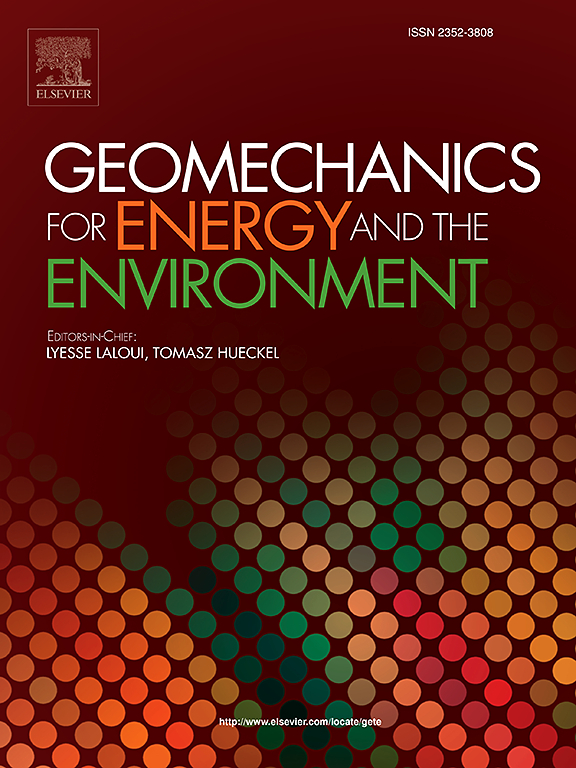Effect of pore fluid chemistry on the mechanical behavior of a divalent compacted bentonite, an experimental and constitutive study
IF 3.7
2区 工程技术
Q3 ENERGY & FUELS
引用次数: 0
Abstract
Ongoing research in isolating high-level nuclear waste and spent fuel has highlighted compacted bentonite as a suitable material for engineered barrier systems in deep geological repositories due to its extraordinary swelling and retention properties. This research focuses on the chemo-mechanical behavior of compacted bentonite exposed to different pore fluids with different concentrations and loading conditions. The study involves swelling pressure and compressibility experiments along with mineralogy analysis employing X-ray diffraction (XRD) and Cation exchange. The tests were conducted on BCV (a Mg/Ca- bentonite) compacted at a dry density of 1.48 ± .02 Mg/m3. An advanced chemical-mechanical constitutive model for unsaturated highly expansive clays was adopted to simulate the material response and better understand its behavior. The model is able to account for the main phenomena at both macro and microstructural levels and the interactions between them. The model successfully replicated experimental observations. The XRD analyses support the macroscopic observation, indicating that salinity impacts crystalline swelling as demonstrated by the reduction of basal spacing from 19.27 Å to 15.68 Å when the osmotic suction increases from 0 MPa to 33 MPa. The results suggested that the osmotic pressure generated by the concentration in the pore fluids promotes a reduction in swelling pressures, swelling strains, and crystalline swelling of clay minerals. Also, it affects the pre-consolidation stress and the compressibility of the compacted samples. It was also observed that both solution type and solution concentration impact the clay swelling pressure.
孔隙流体化学对二价压实膨润土力学行为的影响,实验和本构研究
正在进行的隔离高放核废料和乏燃料的研究表明,由于其非凡的膨胀和保留特性,压实膨润土是深层地质储存库工程屏障系统的合适材料。研究了压实膨润土在不同孔隙流体浓度和加载条件下的化学力学行为。研究包括膨胀压力和可压缩性实验,以及x射线衍射(XRD)和阳离子交换的矿物学分析。试验采用干密度为1.48 ± .02的BCV (a Mg/Ca-膨润土)压实Mg / m3。采用一种先进的非饱和高膨胀粘土化学-力学本构模型来模拟材料响应,更好地理解其行为。该模型能够解释宏观和微观结构层面的主要现象以及它们之间的相互作用。该模型成功地复制了实验观察结果。XRD分析支持宏观观察结果,当渗透吸力从0 MPa增加到33 MPa时,基底间距从19.27 Å减小到15.68 Å,表明矿化度对晶体膨胀有影响。结果表明,孔隙流体中浓度产生的渗透压促进了粘土矿物溶胀压力、溶胀应变和结晶溶胀的降低。此外,它还会影响压实试样的预固结应力和可压缩性。同时还观察到溶液类型和溶液浓度对粘土膨胀压力的影响。
本文章由计算机程序翻译,如有差异,请以英文原文为准。
求助全文
约1分钟内获得全文
求助全文
来源期刊

Geomechanics for Energy and the Environment
Earth and Planetary Sciences-Geotechnical Engineering and Engineering Geology
CiteScore
5.90
自引率
11.80%
发文量
87
期刊介绍:
The aim of the Journal is to publish research results of the highest quality and of lasting importance on the subject of geomechanics, with the focus on applications to geological energy production and storage, and the interaction of soils and rocks with the natural and engineered environment. Special attention is given to concepts and developments of new energy geotechnologies that comprise intrinsic mechanisms protecting the environment against a potential engineering induced damage, hence warranting sustainable usage of energy resources.
The scope of the journal is broad, including fundamental concepts in geomechanics and mechanics of porous media, the experiments and analysis of novel phenomena and applications. Of special interest are issues resulting from coupling of particular physics, chemistry and biology of external forcings, as well as of pore fluid/gas and minerals to the solid mechanics of the medium skeleton and pore fluid mechanics. The multi-scale and inter-scale interactions between the phenomena and the behavior representations are also of particular interest. Contributions to general theoretical approach to these issues, but of potential reference to geomechanics in its context of energy and the environment are also most welcome.
 求助内容:
求助内容: 应助结果提醒方式:
应助结果提醒方式:


